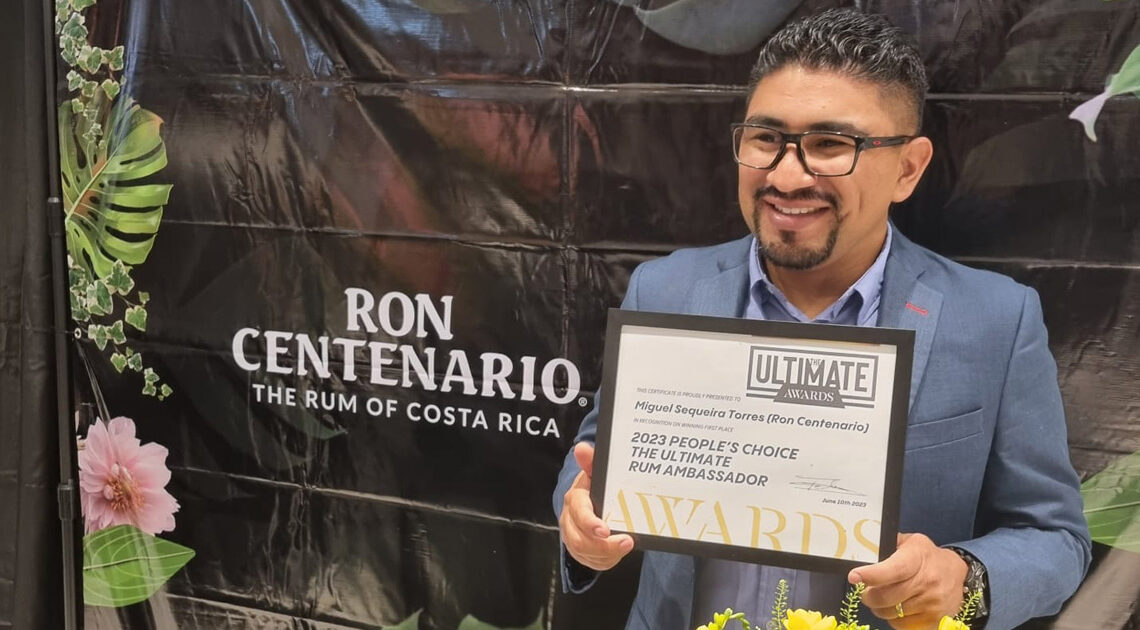Costa Rica – Natural Aging & Art of Blending

On April 27, 2022, a livestream started on the ZAVVY platform, hosted by “The Rum Lab” with the participation of Fede J. Hernández, an entrepreneur specializing in sales and marketing. The guest was Daniel Mora, Global Brand Manager of “Rum Centenario” and a rum connoisseur who will talk about his involvement in the rum industry and his participation in it. Please translate this into English.
Daniel Mora: A Passionate Journey in the World of Rum
Daniel Mora is the Global Brand Manager of Rum Centenario, a position he has held with enthusiasm for the past five years. His journey with Rum Centenario began as a Junior Brand Manager for some local brands. Within six months, his passion and dedication saw him rise to the position of Brand Manager for Rum Centenario. Today, he not only manages the brand but also oversees exports to Latin America, the United States, and Canada.
Mora’s interest extends beyond just rum; he is passionate about spirits in general. As a mixologist, he enjoys creating cocktails and staying updated with the latest trends in the spirits industry. His dedication has significantly contributed to the growth of Centenario, which is now present in 37 different countries, with the United States being the second most important country for their exports.
In addition to his professional pursuits, Mora is an avid collector of rare rum bottles from around the world. His collection at home is a testament to his love for rum. He firmly believes that rum is a drink for all days and considers it to be the best spirit one can find. For Mora, if it’s from Centenario, it’s even better.
The Art of Rum Production in Costa Rica
Daniel Mora, shares his insights on why Costa Rica is an ideal place for rum production. Despite being a small country, Costa Rica is home to 6% of the world’s biodiversity, making it a significant ecological hub in Latin America. This rich biodiversity and unique microclimates greatly benefit the growth of sugarcane and the aging process of rums.
Centenario’s facilities are located in Curridabat, a district of San Jose, situated 1400m above sea level. The location is surrounded by two rivers and a forest, creating a special environment for aging rums. In comparison to other regions where the angel’s share (the amount of alcohol that evaporates from the casks during maturation) can be between 12 to 14%, Centenario’s angel’s share is only 2 to 3%. This low evaporation rate allows for a more artisanal and natural aging process, without the need for additives or flavoring agents.
The ideal weather conditions in Curridabat, with temperatures ranging between 25 to 30 degrees Celsius, contribute to a special environment within their facilities. This natural advantage led to the creation of their brand statement “by nature”. Since its inception in 1969, Centenario recognized the potential of its unique location. However, it wasn’t until 1981 when they began aging their Costa Rican sugarcane in barrels that they realized they had struck gold.
The natural environment provides optimal conditions for aging rums without the need for artificial cooling systems. The rivers surrounding the warehouse keep it fresh every day, making it an ideal place for rum production. This conversation with Daniel Mora offers a fascinating insight into the art of rum production in Costa Rica.
The Unique Aging Process of Ron Centenario
Daniel Mora, the manager of Ron Centenario, shared some fascinating insights about their unique rum aging process. The company, located in San Jose, Costa Rica, is surrounded by two rivers and a lush forest. This environment contributes to a low angel share (the amount of alcohol that evaporates from the casks during aging) of only 2 to 4%, compared to the typical 12 to 14% in Latin America.
The location of the warehouse plays a significant role in this process. It’s situated near Cartago, the highest city in Costa Rica, which is around 1800 meters above sea level. The proximity to a volcano also benefits the company as the water used in their rum production is naturally filtered with volcanic sand.
The company’s commitment to nature is evident in their practices. They have their own water pond, which is monitored by their master blender, Dona Susana. Their facilities are home to 44 different species of birds, and they actively contribute to the growth of nature within their premises.
With a history spanning 37 years and some rums aging since 1969, Ron Centenario’s unique approach to rum production and their harmony with nature truly set them apart in the industry.
The Use of Local Sugarcane in Ron Centenario’s Production
Daniel Mora, clarified the company’s use of local sugarcane in their rum production. Initially, Ron Centenario did not use local sugarcane, but now they do. The company uses molasses distilled by Fabrica Nacional de Licores (FANAL), a government monopoly in Costa Rica. The sugarcane used for these molasses comes from two different regions in Costa Rica: one from the Pacific side (Guanacaste) and the other from the central region (Turrialba). These regions have different altitudes, which results in two distinct types of sugarcane.
Due to Costa Rica’s global position, its sugarcane is sweeter than that grown in other countries. This unique characteristic contributes to the distinct flavor of Ron Centenario’s rums. However, due to certain restrictions, the company cannot distill their own rums and must purchase alcohol from the government. In rare cases where local alcohol is not available, they import alcohol from other countries. Despite this, 90% of their alcohol is sourced from Costa Rica, allowing them to proudly represent their country in their products.
The Evolution of Ron Centenario and Its Unique Aging Process
Daniel Mora, shared the fascinating history and unique aging process of their rum. The company, originally known as Seagrams of Costa Rica, was later sold to Bernard Ricard and became Pernod Ricard of Costa Rica until 2002.
In the early 1980s, the Scottish Government granted Costa Rica a special permit to bottle Scotch whisky outside of Scotland. This led to the arrival of a million barrels filled with Scotch whiskies and malts from renowned brands. On September 15th, 1981, these barrels were filled with distilled spirits from Costa Rica, marking the beginning of premium rum production in the country.
What sets Ron Centenario apart is its unique aging process. It is the only rum brand in the world that ages its rums in Scotch whisky barrels. These barrels, sourced from Speyside, Highlands, Lowlands, and Islay, impart a unique flavor profile to their rums. Despite not having control over the distillation process, Ron Centenario takes pride in their aging process.
The company also uses natural ingredients and maintains a strong commitment to nature. Their portfolio ranges from a 4-year-old white rum to a 30-year-old rum, all carrying distinct whisky notes due to their unique aging process. This makes Ron Centenario a favorite among locals and contributes to its uniqueness in the global rum market.
The Art of Aging and Blending at Ron Centenario
Daniel Mora, explained the company’s unique approach to creating and innovating in the rum category. Their rums are aged in barrels that previously held renowned Scottish whiskies, which imparts a distinct flavor to their products. This makes their rums particularly appealing to mixologists and those who enjoy sipping rums.
The company has a history of creating specific rums to cater to different markets. For instance, the 20-year-old rum was created for the German market, while the 25-year-old rum was developed for the United States. Each of these rums has a distinct flavor profile tailored to the palate of consumers in those regions.
When it comes to age statements, Ron Centenario follows a traditional aging system for their rums. These rums are kept in barrels for the specified number of years and then blended from different barrels of the same age. For example, their 12-year-old rum is a blend of 50% from barrels from the Highlands and 50% from barrels from the Lowlands.
In addition to their traditional aging system, Ron Centenario also uses a solera system for some of their rums. This unique approach to aging and blending contributes to the distinct character and quality of Ron Centenario’s products.
Ron Centenario’s Aging Process and New Labeling Regulations
Daniel Mora, explained the company’s aging process for their rum. All of their rums are aged for a specific number of years, such as 4, 5, 7, 9, or 12 years. When they need to create a rum of a certain age, they take all the barrels that have been aging for that number of years, blend them, and then bottle them. This process ensures that all the rums are of the exact age stated.
This aging process is a regulation that Ron Centenario has established for itself as a company. Unfortunately, there is no institution in Costa Rica that can certify the age of their rums. Despite this, they have all the necessary documentation to prove the age of their rums.
However, new regulations in the United States and the European Union are affecting how Ron Centenario labels their products. These regions are implementing rules to protect their own spirits, such as Bourbons in the United States and agricole rums in the European Union.
Due to these new regulations and the lack of a certifying institution in Costa Rica, Ron Centenario has had to remove the word “age” from their labels. For example, “Ron Centenario 20 Years Foundation” is now called “Ron Centenario 20 Foundation Anniversary”. This change will be implemented for all their labels in the United States starting from May.
Despite these changes, Ron Centenario remains committed to producing high-quality rum and respecting its consumers. They will continue to age their rums for specific years and maintain transparency about their process.
Ron Centenario’s Labeling and Recognition by the Costa Rican Government
Daniel Mora further explained that while the age of the rum will be indicated on the back label, it cannot be displayed on the front label due to new regulations. This change is particularly relevant in regions like the European Union, which is protecting its Agricole rums.
In response to these changes, Ron Centenario has initiated an “age by nature” process. This allows them to highlight what they have in Costa Rica and aligns with their commitment to sustainability and social responsibility.
Excitingly, a month and a half ago, Ron Centenario received a special recognition from the Costa Rican government. They were awarded the “Essential Costa Rica” stamp, which certifies them as an authentic Costa Rican product. They are the only liquid product in Costa Rica to receive this recognition, which also acknowledges their efforts towards sustainability and social responsibility.
As part of their rebranding, Ron Centenario will be incorporating elements of Costa Rican culture into their labels. For example, “Ron Centenario Seven Provinces” will feature a map of Costa Rica and symbols of its different provinces.
If the Costa Rican government decides to establish a division that certifies the age of rums, Ron Centenario is prepared to include this information on their labels, as they have all the necessary documentation to do so.
Ron Centenario’s Solera System and Natural Aging Process
Daniel Mora discussed the Solera system used by Ron Centenario. Due to new regulations in the European Union, Latin American rums can no longer use the term “Solera”, which is now reserved for cognacs and brandies. Despite this, Ron Centenario continues to use a similar system for their rums.
In their system, they have multiple layers of barrels, with the bottom layer being the Solera. The rums in these barrels are a blend of ages ranging from 6 to 20 years. The rums are moved from one barrel to another in a cascading manner, allowing for a mix of different rums in each barrel.
When the Solera is ready, only 75% of it is bottled. The remaining 25% is returned to the first layer of the pyramid. This process, which they call the “continuous aging barrel process”, allows them to maintain the same organoleptic characteristics across their rums.
This process also enables Ron Centenario to keep their rums completely natural. They do not add any caramels, flavors, or wood chips to their rums. The color, flavors, and smells of their rums come solely from the barrels. In their warehouse, they have different lines of Soleras for each of their premium rums: 20, 25, and 30 years old. Each line contains barrels dedicated to a specific age of rum.
Centenario Rum: A Story of Growth and Innovation
Daniel Mora, shared that the company is not limited in its production capacity. Despite being a relatively young brand at 37 years old, they have seen significant growth, with exports increasing by 45% last year and expansion into 11 new countries in Latin America and Europe.
The company prides itself on its ability to grow without compromising the quality of its products. This is largely due to the strict oversight of Dona Susana, who insists on maintaining the integrity of the brand’s recipes. The centenary is seen as Dona Susana’s voice, and any changes to the brand must be made consciously.
In terms of aging, the company uses ex-Scotch whiskey barrels for their rum. However, they are always looking for ways to innovate. Four years ago, they began experimenting with wine and tequila barrels in a separate area of their warehouse. There are plans for future releases of Centenario aged in these different barrels.
One such innovation is their 1985 rum, which was launched in 2020. The first release was aged only in Highland barrels, but future releases will feature different barrels. These collector’s bottles are expected to be popular among rum connoisseurs worldwide.
Centenario Rum: A Fusion of Tradition and Craftsmanship
Centenario continues to source casks from the Scottish whisky industry, thanks to their strategic partnership with Pernod Ricard in Costa Rica. These barrels are used multiple times due to the high ABV (Alcohol By Volume) of the spirits, which ranges between 55 to 65%.
The Centenario 20, a popular product, is a blend of rums aged in Highlands and Lowlands barrels. The Highlands barrels contribute fruity, caramel, vanilla, and woody notes, while the Lowlands barrels add a smoky and woody character. However, you won’t find any peaty notes in Centenario 20 because it’s a blend of 80% Highlands and 20% Lowlands barrels.
The resulting flavor profile of Centenario 20 includes vanilla, brandy, red apple, sherry, and a slight sweetness. The use of different types of barrels allows Centenario to create unique and complex flavors in their rums.
Featured image: About Drinks












